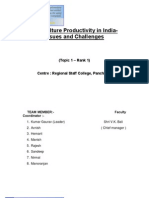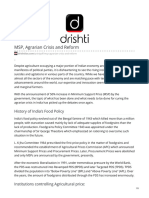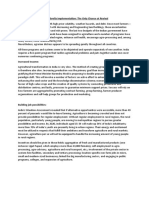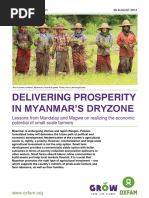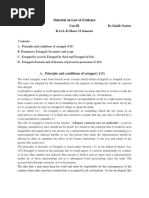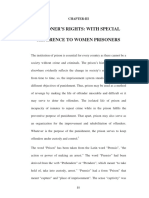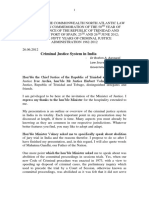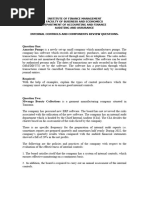Farm Policies For India
Farm Policies For India
Uploaded by
shamaCopyright:
Available Formats
Farm Policies For India
Farm Policies For India
Uploaded by
shamaOriginal Description:
Original Title
Copyright
Available Formats
Share this document
Did you find this document useful?
Is this content inappropriate?
Copyright:
Available Formats
Farm Policies For India
Farm Policies For India
Uploaded by
shamaCopyright:
Available Formats
Insights Mind maps
General Studies-3; Topic: Agriculture issues
Farm Policies for India
1) Introduction
The farmers protesting across India are demanding implementation of Swaminathan Committee's
recommendations, lower input costs, farm loan waiver and fair price for farm produce among other
things.
2) Structural Issues
The one-size-fits-all policy created for the farm sector and programmes meant to double farmer
incomes may not show better results.
No region specific norms in Pradhan Mantri Fasal Bima Yojana force it to distribute benefits in
uneven manner.
States interest in E-NAM is lacking and states like Haryana log in all FCI purchases as E-NAM
transactions.
Whenever there is inflation, centre imports agricultural commodities which lead to fall in prices (Eg:
Last year Pulses import). But when prices fall, the Central government remains apathetic.
No consultation of state governments in negotiating agriculture related trade treaties despite the
fact that agriculture comes under state list.
To meet their priority-sector lending targets, banks have indiscriminately given loans of over Rs one
lakh crore to farmers based on their asset value rather than economic viability.
Sometimes the loans given are more than the actual value of the crops sold each year by individual
farmers.
Loans are also given against the pledge of gold and classified as agricultural loans.
No floor price for all agricultural commodities.
Extra burden on state governments for funding to certain central schemes.
3) Way Forward
Allowing each state to design its own crop insurance scheme and receiving the Central government
share of the premium would yield desired results.
Rather than force E-NAM on states, incentivising each state to have their own electronic platform
which meets the basic criteria of interoperability with other states
Central government should negotiate international trade treaties on agriculture (like RCEP) with the
consent of state governments.
Centre must follow a scientific methodology for importing agricultural commodities so as to
prevent fall in prices.
Our agriculture policy needs to focus on improving productivity
Access to formal credit, rationalizing crop rotation and inputs, and weathering seasonal risks.
Synergy between ministry of food processing with the ministry of agriculture and farmer welfare
Big data analytics will usher in improved governance and transparency.
Centre should set a floor price for all the farm produce. Centre should compensate the farmers for
the shortfall between the market price and floor price through Price Deficiency Payment.
To prepare Indian farmers for global assimilation, funding for programmes like Rashtriya Krishi
Vikas Yojna and the sub-mission on agriculture mechanisation should be doubled.
www.insightsonindia.com Page 1 www.insightsias.com
Insights Mind maps
4) Women farmers need policy attention
The current situation of rural transformation has brought to light womens roles in agriculture.
With men migrating to cities for better jobs, women are now playing a critical role in farming
In the absence of men, women are making farming decisions.
National agricultural policies are not geared to cater to these women farmers.
Often, women are not given due recognition as farmers which hampers their ability to access
productive input.
The potential downside to those women managing farms is the increased workload accompanied
by no reduction in other duties.
This could reduce leisure time, which could, in turn, impact their sense of well-being.
Attitudes regarding womens roles in agriculture must change
Thus, the onus is on policy makers to create a favourable ecosystem for women engaged in farming
by ensuring greater access to physical and financial resources.
www.insightsonindia.com Page 2 www.insightsias.com
You might also like
- Crime Control Through Due ProcessDocument24 pagesCrime Control Through Due Processshama100% (1)
- Forex Trading Strategy: Odd EnhancersDocument15 pagesForex Trading Strategy: Odd EnhancersgreatgeniusNo ratings yet
- Brown-Forman Initiating CoverageDocument96 pagesBrown-Forman Initiating CoverageRestructuring100% (1)
- ISyE 313 Exam 2 2012 FallDocument8 pagesISyE 313 Exam 2 2012 FallChrisy210No ratings yet
- clearias.com-Issues related to direct and indirect farm subsidies and minimum support pricesDocument8 pagesclearias.com-Issues related to direct and indirect farm subsidies and minimum support pricestothetop3011No ratings yet
- Geo PertanianDocument7 pagesGeo PertanianSugeng HermantoNo ratings yet
- Rural Development NotesDocument5 pagesRural Development NotesHarsha AmlaniNo ratings yet
- Insights Mind Maps: Issues Related To MSPDocument2 pagesInsights Mind Maps: Issues Related To MSPrushikesh dharmadhikariNo ratings yet
- Agriculture AssignmentDocument5 pagesAgriculture AssignmentAmandeep Garg0% (1)
- 20.prod Agri ChallDocument7 pages20.prod Agri Challnitin1232No ratings yet
- Project On Economics 2Document7 pagesProject On Economics 2Kritika MalikNo ratings yet
- Farmer Suicides in IndiaDocument2 pagesFarmer Suicides in IndiaGanesh PandeyNo ratings yet
- Chapter One: 1.1 Background of The StudyDocument11 pagesChapter One: 1.1 Background of The StudyPradeep LamsalNo ratings yet
- Agriculture-Industry Interface: Value Added Farm ProductsDocument9 pagesAgriculture-Industry Interface: Value Added Farm ProductsAnanda PreethiNo ratings yet
- Rural DevelopmentDocument40 pagesRural DevelopmentrobockxxNo ratings yet
- Agricultural Sector of Pakistan: BBA-V (Hons)Document8 pagesAgricultural Sector of Pakistan: BBA-V (Hons)IqraarifNo ratings yet
- Innovative Policy Interventions For Transformation of Farm SectorDocument17 pagesInnovative Policy Interventions For Transformation of Farm SectorAjayNo ratings yet
- Farmer SuicideDocument10 pagesFarmer SuicidePRAVEEN KUMARNo ratings yet
- Agricultural Distress in IndiaDocument4 pagesAgricultural Distress in IndialalithkumarNo ratings yet
- Msp-Agrarian-Crisis-And-Reform 8Document5 pagesMsp-Agrarian-Crisis-And-Reform 809puja2003No ratings yet
- Farm Loan WaiverDocument10 pagesFarm Loan Waiverqmkrg79td2No ratings yet
- Agricultural Distress in IndiaDocument10 pagesAgricultural Distress in IndiarajtanniruNo ratings yet
- SWOT Analysis of Indian AgricultureDocument8 pagesSWOT Analysis of Indian AgricultureManthan LalanNo ratings yet
- Impact of Micro Finance On Agricultural SectorDocument5 pagesImpact of Micro Finance On Agricultural SectorArjun Singh TomarNo ratings yet
- Agri 61 Second Semester, 2019-2020 Commentary Paper No. 2 Laurenz James C. de Matta June 8, 2020Document3 pagesAgri 61 Second Semester, 2019-2020 Commentary Paper No. 2 Laurenz James C. de Matta June 8, 2020Laurenz James Coronado DeMatta0% (1)
- Agrarian Crisis in India: An AnalysisDocument18 pagesAgrarian Crisis in India: An AnalysisUtkarsh ShuklaNo ratings yet
- Agrarian Crisis in India PDFDocument5 pagesAgrarian Crisis in India PDFZakir AhmadNo ratings yet
- Agricultural Finance in IndiaDocument5 pagesAgricultural Finance in IndiaEdana SharmaNo ratings yet
- ISSN Publication Impact of Indian Banking Crisis in Agriculture Sector - With Reference To Organic FarmingDocument12 pagesISSN Publication Impact of Indian Banking Crisis in Agriculture Sector - With Reference To Organic FarmingDr. UMA KNo ratings yet
- Unit 2.3Document7 pagesUnit 2.3aditi singhNo ratings yet
- Discuss The Impact of Agriculture On Industrial Development?Document33 pagesDiscuss The Impact of Agriculture On Industrial Development?San Deep SharmaNo ratings yet
- Issues With Agriculture in IndiaDocument4 pagesIssues With Agriculture in Indiachirag.jain8982No ratings yet
- Economy Mains Model Answers 2019Document36 pagesEconomy Mains Model Answers 2019shivankar shuklaNo ratings yet
- One-Umbrella Implementation: The Only Chance at RevivalDocument2 pagesOne-Umbrella Implementation: The Only Chance at RevivalParth Hemant PurandareNo ratings yet
- One-Umbrella Implementation: The Only Chance at RevivalDocument2 pagesOne-Umbrella Implementation: The Only Chance at RevivalParth Hemant PurandareNo ratings yet
- Indian Agriculture Towards 2030: National DialogueDocument53 pagesIndian Agriculture Towards 2030: National DialogueAadhityaNo ratings yet
- Priority Issues: For Indonesian AgricultureDocument6 pagesPriority Issues: For Indonesian AgricultureSurjadiNo ratings yet
- Eco Notes-1Document39 pagesEco Notes-1aniketsawant8003No ratings yet
- The Impact of Agricultural Subsidies on Cropping Patterns and Farmer Econo_20241126_100543_0000 (1)Document6 pagesThe Impact of Agricultural Subsidies on Cropping Patterns and Farmer Econo_20241126_100543_0000 (1)Shreya YugalNo ratings yet
- NAYANTARA SENGUPTA - XIB - 22 - Economics ProjectDocument16 pagesNAYANTARA SENGUPTA - XIB - 22 - Economics Projectnayantara.senguptaug25No ratings yet
- Report of The ITC Board of DirectorsDocument5 pagesReport of The ITC Board of Directors331239No ratings yet
- EditorialsDocument6 pagesEditorialsayush shrotriyaNo ratings yet
- PEST Analysis of India (Agriculture)Document12 pagesPEST Analysis of India (Agriculture)sainathvms75% (4)
- NITI Aayog Repor1 EditorialDocument6 pagesNITI Aayog Repor1 EditorialKamran firozNo ratings yet
- Delivering Prosperity in Myanmar's Dryzone: Lessons From Mandalay and Magwe On Realizing The Economic Potential of Small-Scale FarmersDocument40 pagesDelivering Prosperity in Myanmar's Dryzone: Lessons From Mandalay and Magwe On Realizing The Economic Potential of Small-Scale FarmersOxfamNo ratings yet
- Delivering Prosperity in Myanmar's Dryzone: Lessons From Mandalay and Magwe On Realizing The Economic Potential of Small-Scale FarmersDocument40 pagesDelivering Prosperity in Myanmar's Dryzone: Lessons From Mandalay and Magwe On Realizing The Economic Potential of Small-Scale FarmersOxfamNo ratings yet
- Delivering Prosperity in Myanmar's Dryzone: Lessons From Mandalay and Magwe On Realizing The Economic Potential of Small-Scale FarmersDocument40 pagesDelivering Prosperity in Myanmar's Dryzone: Lessons From Mandalay and Magwe On Realizing The Economic Potential of Small-Scale FarmersOxfamNo ratings yet
- Delivering Prosperity in Myanmar's Dryzone: Lessons From Mandalay and Magwe On Realizing The Economic Potential of Small-Scale FarmersDocument40 pagesDelivering Prosperity in Myanmar's Dryzone: Lessons From Mandalay and Magwe On Realizing The Economic Potential of Small-Scale FarmersOxfamNo ratings yet
- Delivering Prosperity in Myanmar's Dryzone: Lessons From Mandalay and Magwe On Realizing The Economic Potential of Small-Scale FarmersDocument40 pagesDelivering Prosperity in Myanmar's Dryzone: Lessons From Mandalay and Magwe On Realizing The Economic Potential of Small-Scale FarmersOxfamNo ratings yet
- Delivering Prosperity in Myanmar's Dryzone: Lessons From Mandalay and Magwe On Realizing The Economic Potential of Small-Scale FarmersDocument40 pagesDelivering Prosperity in Myanmar's Dryzone: Lessons From Mandalay and Magwe On Realizing The Economic Potential of Small-Scale FarmersOxfamNo ratings yet
- Delivering Prosperity in Myanmar's Dryzone: Lessons From Mandalay and Magwe On Realizing The Economic Potential of Small-Scale FarmersDocument40 pagesDelivering Prosperity in Myanmar's Dryzone: Lessons From Mandalay and Magwe On Realizing The Economic Potential of Small-Scale FarmersOxfamNo ratings yet
- Delivering Prosperity in Myanmar's Dryzone: Lessons From Mandalay and Magwe On Realizing The Economic Potential of Small-Scale FarmersDocument40 pagesDelivering Prosperity in Myanmar's Dryzone: Lessons From Mandalay and Magwe On Realizing The Economic Potential of Small-Scale FarmersOxfamNo ratings yet
- Delivering Prosperity in Myanmar's Dryzone: Lessons From Mandalay and Magwe On Realizing The Economic Potential of Small-Scale FarmersDocument40 pagesDelivering Prosperity in Myanmar's Dryzone: Lessons From Mandalay and Magwe On Realizing The Economic Potential of Small-Scale FarmersOxfamNo ratings yet
- Delivering Prosperity in Myanmar's Dryzone: Lessons From Mandalay and Magwe On Realizing The Economic Potential of Small-Scale FarmersDocument40 pagesDelivering Prosperity in Myanmar's Dryzone: Lessons From Mandalay and Magwe On Realizing The Economic Potential of Small-Scale FarmersOxfamNo ratings yet
- Delivering Prosperity in Myanmar's Dryzone: Lessons From Mandalay and Magwe On Realizing The Economic Potential of Small-Scale FarmersDocument40 pagesDelivering Prosperity in Myanmar's Dryzone: Lessons From Mandalay and Magwe On Realizing The Economic Potential of Small-Scale FarmersOxfamNo ratings yet
- Delivering Prosperity in Myanmar's Dryzone: Lessons From Mandalay and Magwe On Realizing The Economic Potential of Small-Scale FarmersDocument40 pagesDelivering Prosperity in Myanmar's Dryzone: Lessons From Mandalay and Magwe On Realizing The Economic Potential of Small-Scale FarmersOxfamNo ratings yet
- Delivering Prosperity in Myanmar's Dryzone: Lessons From Mandalay and Magwe On Realizing The Economic Potential of Small-Scale FarmersDocument40 pagesDelivering Prosperity in Myanmar's Dryzone: Lessons From Mandalay and Magwe On Realizing The Economic Potential of Small-Scale FarmersOxfamNo ratings yet
- Delivering Prosperity in Myanmar's Dryzone: Lessons From Mandalay and Magwe On Realizing The Economic Potential of Small-Scale FarmersDocument40 pagesDelivering Prosperity in Myanmar's Dryzone: Lessons From Mandalay and Magwe On Realizing The Economic Potential of Small-Scale FarmersOxfamNo ratings yet
- Delivering Prosperity in Myanmar's Dryzone: Lessons From Mandalay and Magwe On Realizing The Economic Potential of Small-Scale FarmersDocument40 pagesDelivering Prosperity in Myanmar's Dryzone: Lessons From Mandalay and Magwe On Realizing The Economic Potential of Small-Scale FarmersOxfamNo ratings yet
- Agricultural Marketing in India: Anirban Biswas 13 July 2004Document17 pagesAgricultural Marketing in India: Anirban Biswas 13 July 2004Geetha K. S. GeethaNo ratings yet
- Agricultural Finance for Smallholder Farmers: Rethinking Traditional Microfinance Risk and Cost Management ApproachesFrom EverandAgricultural Finance for Smallholder Farmers: Rethinking Traditional Microfinance Risk and Cost Management ApproachesNo ratings yet
- EstoppelDocument19 pagesEstoppelshamaNo ratings yet
- Jurimetrics AssignmentDocument22 pagesJurimetrics AssignmentshamaNo ratings yet
- 101 (WWW - Sarkarijobtips.com) History Important Prelims Questions Final File PDFDocument40 pages101 (WWW - Sarkarijobtips.com) History Important Prelims Questions Final File PDFshamaNo ratings yet
- Haryana & Legal GK & Current AffairsDocument28 pagesHaryana & Legal GK & Current AffairsshamaNo ratings yet
- Plaint 2Document5 pagesPlaint 2shamaNo ratings yet
- BOOK REVIEW Dalit Women Speak Out CasteDocument61 pagesBOOK REVIEW Dalit Women Speak Out CasteshamaNo ratings yet
- BOOK REVIEW Dalit Women Speak Out Caste PDFDocument3 pagesBOOK REVIEW Dalit Women Speak Out Caste PDFshamaNo ratings yet
- Written Statement 1Document6 pagesWritten Statement 1shamaNo ratings yet
- Joga Rao S. V (2004), Law of Cyber Crimes & Information Technology Law. 1st Edition, p.46Document21 pagesJoga Rao S. V (2004), Law of Cyber Crimes & Information Technology Law. 1st Edition, p.46shamaNo ratings yet
- Prisoner'S Rights: With Special Reference To Women PrisonersDocument56 pagesPrisoner'S Rights: With Special Reference To Women PrisonersshamaNo ratings yet
- Current Affairs Q&A PDF Free - September 2018Document35 pagesCurrent Affairs Q&A PDF Free - September 2018shamaNo ratings yet
- Bibliography:: A. Guidelines and Reports of United Nations Organisations (UNO)Document8 pagesBibliography:: A. Guidelines and Reports of United Nations Organisations (UNO)shamaNo ratings yet
- Criminal Justice System in IndiaDocument9 pagesCriminal Justice System in IndiashamaNo ratings yet
- Book Review PDFDocument6 pagesBook Review PDFshamaNo ratings yet
- Fig. 1Document10 pagesFig. 1shamaNo ratings yet
- Relationship Between Criminology and Sociology PDFDocument26 pagesRelationship Between Criminology and Sociology PDFshamaNo ratings yet
- Comparative Analysis of Merchant Banking Services in Public Sector Bank & Private Sector BankDocument37 pagesComparative Analysis of Merchant Banking Services in Public Sector Bank & Private Sector BankAmarbant Singh DNo ratings yet
- Annual Report 2008 Web - RynairDocument96 pagesAnnual Report 2008 Web - RynairshekharwithyouNo ratings yet
- Common Size Analysis TemplateDocument4 pagesCommon Size Analysis TemplateMuhammad FarooqNo ratings yet
- Cambridge International AS & A Level: BUSINESS 9609/21Document4 pagesCambridge International AS & A Level: BUSINESS 9609/21yyovitakutwarooNo ratings yet
- Why The UccDocument11 pagesWhy The UccI have rejoined myself with the cause by Charles W. Iseley/Isley for personal reasons. I'll follow the Sun.100% (2)
- Public Ruling No. 3-2011 Investment Holding CompanyDocument27 pagesPublic Ruling No. 3-2011 Investment Holding CompanyKen ChiaNo ratings yet
- Sargon FintechDocument11 pagesSargon FintechMorsten PlackNo ratings yet
- Press Release Crypto Research Report English.01Document5 pagesPress Release Crypto Research Report English.01AndreiNo ratings yet
- Professional Experience (48 Months) : 4/4,2 Floor, Atur Park, Chembur, Mumbai, S.T Road-400071 +91 9920 837 809Document1 pageProfessional Experience (48 Months) : 4/4,2 Floor, Atur Park, Chembur, Mumbai, S.T Road-400071 +91 9920 837 809baburaoNo ratings yet
- CASE STUDY Ayala Group of CompanyDocument18 pagesCASE STUDY Ayala Group of CompanyAlvin DimasacatNo ratings yet
- Good Governance and Social ResponsibilityDocument3 pagesGood Governance and Social ResponsibilityAccounting MaterialsNo ratings yet
- Digital Skills SbiDocument34 pagesDigital Skills SbiRathiAmritNo ratings yet
- Exide Life New Fulfilling Life Anticipated Whole Life Plan (Fla) (Uin 114n024v01)Document11 pagesExide Life New Fulfilling Life Anticipated Whole Life Plan (Fla) (Uin 114n024v01)satheeskumar VikramasingarajNo ratings yet
- The Truth About MoneyDocument21 pagesThe Truth About MoneyTaha MirNo ratings yet
- Act201 Ch2 NNHDocument35 pagesAct201 Ch2 NNHTiloma M. ZannatNo ratings yet
- Internal Controls and Components Review QuestionsDocument4 pagesInternal Controls and Components Review QuestionsmurshidalbimaanyNo ratings yet
- Chithra Baskar: Account StatementDocument5 pagesChithra Baskar: Account StatementSarath KumarNo ratings yet
- 7 - Employee Development Methods in HRMDocument18 pages7 - Employee Development Methods in HRMRana SabNo ratings yet
- Bcom 3 Sem Corporate Accounting 1 19102078 Oct 2019Document5 pagesBcom 3 Sem Corporate Accounting 1 19102078 Oct 2019xyxx1221No ratings yet
- John CV PDFDocument8 pagesJohn CV PDFrwomubitooke johnNo ratings yet
- LME Monthly Average PricesDocument4 pagesLME Monthly Average PricesEmreNo ratings yet
- Audit of Investments May 2028Document8 pagesAudit of Investments May 2028kmarisseeNo ratings yet
- Chapter - 5 - Insurance Intermediaries1568157534206075349Document34 pagesChapter - 5 - Insurance Intermediaries1568157534206075349Mahima MaharjanNo ratings yet
- Annexures BelDocument5 pagesAnnexures BelManikantavarma MahaliNo ratings yet
- Acctg 202 Di Pa FinalDocument10 pagesAcctg 202 Di Pa FinalJoshua CabinasNo ratings yet
- Salary slip ( 50554264 July , 2024 ).PDFDocument1 pageSalary slip ( 50554264 July , 2024 ).PDFmohammad muzamilNo ratings yet
- Tutorial 4: Portfolio TheoryDocument19 pagesTutorial 4: Portfolio TheorystellaNo ratings yet









